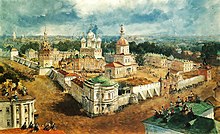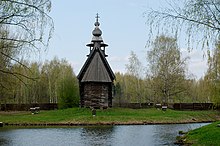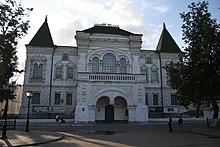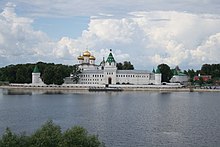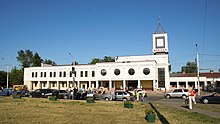Kostroma
| city
Kostroma
Кострома
|
||||||||||||||||||||||||||||||||||||||||
|
||||||||||||||||||||||||||||||||||||||||
|
||||||||||||||||||||||||||||||||||||||||
| List of cities in Russia | ||||||||||||||||||||||||||||||||||||||||
Kostroma ( Russian Кострома́ ) is a Russian city with 268,742 inhabitants (as of October 14, 2010). It is located about 300 kilometers northeast of Moscow at the confluence of the Volga and the Kostroma rivers and is one of the oldest and most architecturally attractive Russian cities and part of the Golden Ring tourist route . It is also the capital of Kostroma Oblast .
history
Based on the widespread founding hypothesis of the city, Kostroma is five years younger than Moscow . Thus it is one of the oldest cities in the central European part of Russia.
Early history and etymology
Nowadays it is generally assumed that Kostroma was founded in 1152. This was first asserted in the 18th century by the well-known Russian historian Vasily Tatishchev , who cited a document that is no longer preserved to the Suzdal Grand Duke Juri Dolgoruki (who is said to have founded Moscow five years earlier) when he expanded to the upper Volga region attributed. The first documented mention of Kostroma, which can be documented to this day, comes from the year 1213: There the place was described in connection with a campaign of the Rostov prince Konstantin , who is said to have burned Kostroma. In 1238 Kostroma was mentioned again in chronicles, this time in connection with an attack by Batu Khan .
Since there is hardly any data that has survived with regard to the town history of Kostroma in the 12th and early 13th centuries apart from these two mentions, the place name cannot be explained with certainty either. Like the hydronym of the river of the same name, the name Kostroma could have come from one of the Finno-Ugric languages and originally meant kostrum , literally “fortress”. According to another version, the place was named after the East Slavic deity named Kostroma, who was worshiped as the fertility goddess by pre-Christian residents of this area. Both hypotheses of the origin of the name suggest that the present-day urban area of Kostroma was inhabited long before the city was supposed to be founded.
Kostroma in the Middle Ages
The first fortified village as the forerunner of today's city could have emerged in the 1240s, when the Vladimir Grand Duke Yaroslav II Vsevolodovich received the area from the Golden Horde , which at that time controlled most of the Russian principalities as a result of the Mongol invasion of the Rus . On the high left bank of the Volga, surrounded by forests, the first wooden fortress, a forerunner of the later (now no longer preserved) Kremlin of Kostroma, could have been built. In addition, Jaroslaw had the first known church building in Kostroma, the wooden church of Theodor Stratelates , built there. After Yaroslav's death in 1246, his son Vasily Yaroslavich got the upper hand over Kostroma. During his reign, which lasted 30 years, Kostroma was at times an independent principality, but went back to Vladimir after his death.
Under Vasily Jaroslawitsch, the Savior Monastery was founded near the Kostroma estuary behind the pond , which today is reminiscent of the church of the same name at that point. Probably around the beginning of the 14th century, the Ipatios Monastery , which is still known today, was built there , which was equipped with fortifications and thus should protect the city from attacks.
In 1364 Kostroma became part of the Grand Duchy of Moscow after the reorganization of the Russian principalities . Due to its strategically favorable location on the high bank of the Volga, the site was repeatedly used as a place of refuge by Moscow grand dukes in critical times: Dmitri Donskoi and his family sought protection there in 1382 when the Khan Toktamisch attacked Moscow. It can be assumed that in the 14th and 15th centuries the city essentially consisted of wooden structures, churches and city fortifications were also made of wood. As everywhere in Russian countries, this encouraged frequent fires in which large parts of the building fabric were destroyed. In the urban area of Kostroma, not a single wooden structure has survived from the Middle Ages to this day.
Kostroma in Tsarist Russia
From the 16th century the rise of Kostroma began to become one of the most important cities in the now united tsarist Russia . In particular, the Ipatios Monastery enjoyed an unprecedented reputation at the end of the 16th century thanks to the fact that its founder was considered an ancestor of the respected boyar family Godunow and enjoyed numerous donations from the Godunow family. Construction activities began there, during which some structures that have been preserved to this day were created - they are today among the oldest architectural monuments in the city. During the short reign of Boris Godunov as the Russian tsar, today's fortifications of the monastery were built.
Only a few years later, during the so-called Smuta , the monastery and thus all of Kostroma were at the center of political events in Russia. In 1608 the monastery was occupied by an army of Polish-Lithuanian foreign rulers, supported by supporters of the so-called second false Dimitri , and used as a military base. Only after several months of siege did a Russian army manage to take the monastery in September 1609. In the spring of 1613 the monastery offered the future Tsar Michael , the first from the Romanov family , temporary refuge from a Polish commando, which failed because of the selfless efforts of the farmer Ivan Sussanin , who later became a national hero . Since Michael was elected tsar a little later in the Ipatios monastery, Kostroma has since been regarded as a kind of cradle of the Romanov house, which every Russian tsar used to visit at least once until the end of the monarchy in Russia.
Creation of today's cityscape
In the 17th century Russia recovered from the turmoil of the Smuta and Kostroma also gained noticeably in economic importance, thanks in part to its convenient location. By the middle of the century Kostroma was already the third largest city in tsarism after Moscow and Yaroslavl , whereby the proximity of the latter contributed significantly to Kostroma's economic prosperity. At that time, handicrafts played the largest role in the city, including iron forging and soap making. The still frequent major fires meant that stone construction gradually began to take hold in Kostroma as well. This is how striking buildings arose outside the Ipatios Monastery, some of which are still standing today. The Church of the Resurrection of Christ in the forest and the buildings of the Epiphany Monastery are worth mentioning . The center of the city was the Kremlin, which rose on the banks of the Volga, while the fan-shaped urban structure that existed to this day began to form around it.
In the 18th century, the cultivation of flax and the textile industry in and around Kostroma became the leading industry. The first manufactories emerged in the city, and the architectural ensemble of the city center was supplemented by noble merchant residences, not a few of which are still standing today. In 1767 Kostroma welcomed Empress Catherine the Great with jubilation on her journey along the Volga. Shortly afterwards it was given its own city coat of arms with a picture of a galley , which symbolized Katharina's visit. In the course of the administrative reform of the 1770s, Kostroma received the status of the capital of an independent government within the Russian Empire in 1778 .
After large parts of the mainly wooden town center were destroyed in a major fire in 1773, all representative buildings in Kostroma were only made of stone. This was anchored in the new general plan from 1781, which is essentially formative for the development of the historical part of Kostroma that still exists today. In the following decades the most famous buildings in the city were built according to this plan: in the 1790s the trade ranks, 1806–1808 the government administration building (today city administration) and in the 1820s the adjoining empire buildings of the Hauptwache and the Fire tower . The fan-like street network around the Kremlin and the central square (today's Sussanin Square), which was determined by history, was retained when the city was rebuilt.
20th century
The industrialization reached in Kostroma late 19th and early 20th century its peak. One of the most important companies in the city at that time was the linen factory , which was founded with the participation of the well-known art patron Pavel Tretyakov . In 1887 Kostroma received a railway connection with the laying of the line from Yaroslavl via Nerechta . In 1913, Kostroma was the center of public interest for the last time when it became one of the central venues for the pompous celebrations of the 300th anniversary of the Romanov dynasty.
Kostroma's reputation as the cradle of the Romanov house, which was cultivated in the Russian Empire, was practically wiped out with the fall of the Russian monarchy after the February and October revolutions in 1917, and for several decades Kostroma also lost its title of provincial capital: at the beginning of 1929 the governorate became Kostroma officially dissolved and became part of the new Yaroslavl and Ivanovo oblasts , today 's Kostroma Oblast with Kostroma as its capital was not formed until 1944. At the same time began here in the 1930s, as in many places in the Soviet Union , a second wave of industrialization one, so among other things, a new was Kombinat taken Leinverarbeitung in operation. During the Second World War , Kostroma, which was located in the Soviet hinterland, was largely spared from German bombing. This fact is largely due to the good preservation of its architectural monuments, but also to the rapid economic development in the post-war period. In the 1960s and 1970s, completely new industrial companies and one of the largest thermal power stations in Europe were built in Kostroma .
Kostroma has been part of the popular tourist route of the Golden Ring since the 1970s and is of steadily growing importance for tourism .
Population development
| year | Residents |
|---|---|
| 1825 | 16,874 |
| 1870 | 27,178 |
| 1897 | 41,336 |
| 1939 | 121,325 |
| 1959 | 171,720 |
| 1970 | 223.042 |
| 1979 | 254.725 |
| 1989 | 278.414 |
| 2002 | 278,750 |
| 2010 | 268,742 |
Note: from 1897 census data
Architecture and landmarks
Due to the comparatively good preservation of the historical building fabric from the 18th and 19th centuries, Kostroma is one of the most architecturally attractive cities in Russia today. The old town is very easy to see through the largely preserved fan-like network of large and small streets, which begin at the central square, even for a stranger; most of the sights there are within walking distance of each other. Outside of the old town, the Ipatios Monastery is one of the main attractions of Kostroma.
Old town
With its historical buildings, the entire old town resembles a classicist open-air museum. In addition to the magnificent classical buildings from the 18th and 19th centuries, there are other buildings from different eras.
Trade rows
The trading rows ( Торговые ряды ) on the slope from Sussanin Square to the Volga River are among the most famous buildings in Kostroma. This is a coherent complex of a good twenty buildings, many of which still house various shops and market stalls today. The core of the trade row complex consists of the rows of flour ( Мучные ряды ), the gingerbread rows ( Пряничные ряды ) and the fish rows ( Рыбные ряды ); They are elongated buildings with arcade-like external galleries and an inner courtyard above the floor plan of a large rectangle , in which merchants once offered their goods and in which there is still brisk trade on weekdays. These rows together represent an early classical ensemble. The Church of the Savior in the trading rows ( Церковь Спаса в Рядах ) with its baroque bell tower, which with its Doric portico forms the prelude to the trading center, is also known. Even the Empire style is represented in trade rows complex, with the butter rows ( Масляные ряды ) and the tobacco rows ( Табачные ряды ) of 1819, on the draft of the well-known architect Vasily Stasov was involved.
Sussanin Square
The Susanin Square ( Сусанинская площадь ) was named after the national hero Ivan Susanin named, who came from the area around Kostroma and whose monument rises between the square and trade rows today. It has always been the central square of the city and the center of the characteristic fan-like street network of Kostroma, from which the main radial streets start.
In addition to the trading rows and the Sussanin monument, which close off the square to the south-west, his ensemble consists of several individual houses, all of which were built in the late 18th and early 19th centuries and are still characteristic of Kostroma's old town. There are the imperial yellow fire watchtower ( Пожарная каланча ) from 1823, which belongs to the fire brigade to this day, right next to it the former main guard ( Гауптвахта ), the courthouse, the former residential palace of General Borschtschow (1819–24), and the former governorate administration today's city administration, built 1806-1808 by Adrian Sakharov , who also built the Admiralty in Saint Petersburg . These buildings, which can also be assigned to the Empire, form an extraordinary framework around the trading rows.
Remaining old town
The architectural ensemble of Sussanin-Platz is complemented by the classicist development of all the streets that branch off from it. The two arterial roads Prospekt Mira ( Проспект Мира ) and Sovetskaya Ulitsa ( Советская улица ), whose districts closest to Sussanin Square are particularly rich in historical buildings, should be mentioned. On Prospect Mira, for example, there is the art museum in the former house of the nobility assembly, a classicist palace that was rebuilt in the historicist style in the second half of the 19th century . Right next to it is the building of the Ostrowski Drama Theater ( Драматический театр имени Островского ) , which was built in 1863 and which still houses one of the oldest theaters in the Russian province.
The Epiphany Monastery ( Богоявленский монастырь ), a few hundred meters north of Sussanin Square, is another gem crowned by the Cathedral of the Appearance of Christ from 1559-1565 (which is the oldest surviving structure in Kostroma) a total work of art from many eras. It was further expanded in the 19th century.
If you walk from Sussanin Square past the trading rows in the direction of the Volga, you will see picturesque little streets, the buildings of which also date almost exclusively from the time before the 20th century. Directly on the bank is the so-called Ostrowski Pavilion ( Беседка Островского ) another of Kostroma's landmarks. It is a seven-column portico in the shape of a rotunda , which was built in 1956 in memory of the famous playwright Alexander Ostrowski , who frequently visited Kostroma. The pavilion stands over the bank on an artificial hill that was once part of the earth walls around the Kostroma Kremlin. Nothing remains of the Kremlin itself except these ramparts: the wooden fortifications burned down in 1773, and the two cathedrals that once rose above the Volga promenade were demolished in 1934 as part of the anti-religious campaign of the early Soviet period.
A little south of the old town, near the automobile bridge over the Volga, stands the Church of the Resurrection of Christ in the forest ( Церковь Воскресения на Дебре ) from 1652, which is a vivid example of the extraordinary wealth of decorative forms in Russian architecture of the 17th century represents.
North of the old town
In ipatievsky monastery , the right at the mouth of Kostroma in the Volga is picturesquely situated, is holding Mikhail Romanov on when it received the news in January 1613 that he from the Moscow Zemsky Sobor the Czar was chosen. As Mikhail he was the first tsar of the Romanov dynasty, which provided the tsars until the October Revolution of 1917. In the monastery there is, among other things, a neat palace from the late 16th century, which temporarily served as accommodation for the Romanovs and is therefore known as the Romanov Palace ( Палата Романовых ). In the 19th century, in the wake of the rise of historicism , the monastery was rebuilt and expanded with the participation of the architect Konstantin Thon , who also built the Cathedral of Christ the Savior in Moscow.
There are two other tourist attractions right next to the monastery: on the one hand the Kostromskaja Sloboda ( Костромская слобода ), an open-air museum for wooden architecture opened in 1960 with historic wooden houses and wooden churches of typical Russian construction, and on the other hand the St. John's Church ( Церковь Иоансл ) from the Year 1681, which is still surrounded by an old, overgrown churchyard with graves of respected clergymen. Also worth seeing is the development of the old industrial district, including the linen factory ( Льняная мануфактура ), which is still in operation today, opposite the Ipatios monastery on the southern bank of the Kostroma. Nearby there is the Church of the Savior behind the pond ( Церковь Спаса на Запрудне ) from 1754, a typical monument of the so-called Naryshkin Baroque .
Behind the Volga
The part of Kostroma on the right bank of the Volga was not part of the urban area when the development plan of 1781 was implemented and therefore has far fewer architectural monuments than the left bank. The city quarters directly on the Volga are still very rural with typical Russian wooden houses and narrow, sometimes unpaved streets. A little further from the bank, new districts dominate the cityscape.
Probably the most famous sight on the right bank is the Church of the Birth of Christ ( Церковь Рождества Христова на Городище ), which is often referred to as the Prophet Elijah Church . It was built around the middle of the 17th century and belonged for a few years in the same century, together with the village of Gorodishche , then located there, to the well-known old Orthodox activist Feodosia Morosova . In the 18th century, the church was rebuilt at least twice and received a bell tower that has baroque shapes. The church stands on a hill near the bank of the Volga.
Mention should also be made of the old orthodox Church of the Transfiguration of Christ ( Церковь Преображения Господня ) from 1688, which is within walking distance of the Church of the Nativity of Christ, as well as the listed building of the disused old train station, a long, decorative carved wooden house in the middle area.
economy
The main branches of business are the textile industry, light industry, automotive supply, wood processing and agriculture, which benefit from the oblast's less industrialized hinterland. One of the most important mineral water springs in Russia is located in Kostroma Oblast. In Krasnoye on the Volga, about 70 kilometers away, there is a jewelry combine.
In 1980 , construction of the Kostroma nuclear power plant began 75 kilometers northeast near the town of Tschistyje Bory . After the Chernobyl disaster , construction work was stopped and later finally ceased. Since 2007, the project has been pursued again together with the Oblasts of Yaroslavl and Ivanovo under the project name Kernkraftwerk Zentral .
traffic
Car traffic
Kostroma is not connected to the Russian highway network; the most important national road connection is with the M8 main road via Yaroslavl . The biggest arterial roads of the city is Highway, the Kostroma with neighboring larger towns (including Yaroslavl, Kineshma , Volgorechensk or Sudislavl ) connect. These major arterial roads include Prospekt Mira ( Проспект Мира ) and the Sovetskaya Ulitsa ( Советская улица ), both of which begin at Sussanin Square in the city center. The automobile bridge over the Volga, built in 1970 and practically the only connection to the city center for residents of the districts on the right bank of the Volga, plays an important role in both inner-city and overland traffic. A number of bus and trolleybus lines also run over this bridge.
Rail transport
In addition to the automobile bridge, within Kostromas, further south of the city center, there is a railway bridge over the Volga. It was built in the 1930s and is a pure railway bridge with no pedestrian walkway. Before it was built, only the right-hand Volgaufer Kostromas had been connected to the rail network since 1887: The route laid from Yaroslavl via Nerechta ended at a terminus that was almost opposite the historic old town. For this reason, the construction of a Volga bridge from there did not seem feasible, since in such a case the tracks would have practically cut the historic old town. Instead, the railway line was moved in the 1930s, bypassing the old terminal station, over the newly built bridge, past the city's new central station, which was given the name Kostroma Nowaja (literally "Kostroma new"). Today Kostroma Nowaja is the only passenger station on the left bank of the Volga in Kostroma and at the same time the city's long-distance station. Trains to and from Moscow and other cities leave here, as do some local trains ( electric trains to Yaroslavl and Nerechta, and diesel trains to Galitsch ).
Air traffic
Kostroma has a small regional airport. This is called Sokerkino (Russian Сокеркино , the ICAO code is UUBA ), is located in the extreme northeast of the urban area on the highway towards Bui and manufactures passenger flights with small aircraft to and from St. Petersburg and in summer to Voronezh, Anapa and in small towns and villages from Kostroma Oblast. The three international Moscow airports are ideal for medium and long-haul flights as well as international connections.
Waterways
There are also numerous landing stages for ships on the left bank of the Volga near the old town. They are mainly used by cruise ships.
Local public transport
In addition to the railway, numerous bus routes play a role in overland transport, most of which start and end at the central bus station on the eastern edge of the city, a few minutes' walk from the main train station.
The inner-city public transport network is also characterized by regular buses and minibuses (so-called marshrutki ), which are widely used in Russia and mostly operated by private providers . The trolleybuses also play an extremely important role in Kostroma, and they currently run on eight lines every ten minutes. The first trolleybus line was put into operation in Kostroma on January 10, 1974.
Further educational institutions
- Kostroma State Nekrasov University
- Kostroma State Technological University
- Kostroma State Agricultural Academy
- Military academy for biological, chemical and radiation protection
Personalities
sons and daughters of the town
- Fyodor Volkov (1729–1763), founder of the first Russian theater in Yaroslavl
- Alexei Pleschtschejew (1825-1893), poet
- Witali Polenow (1901–1968), Lieutenant General
- Ilja Mussin (1904–1999), conductor
- Innokenti Gerasimow (1905–1985), geographer and soil scientist
- Jelisaveta Dementjewa (* 1928), canoeist
- Vyacheslav Lebedev (1930–2010), mathematician
- Anatoli Scheljuchin (1930–1995), cross-country skier
- Alexander Prschewuski (* 1939), solid-state physicist and university professor
- Hans-Werner Gessmann (* 1950), German professor at the Kostroma State University
- Nikolai Muchin (* 1955), painter and sculptor
- Andrei Schljapnikow (* 1959), track and field athlete
- Olesja Barel (* 1960), basketball player
- Ljubov Belych (* 1961), painter
- Sergei Pugachev (* 1963), oligarch and banker
- Tikhon (Stepanow) (1963-2010), Russian Orthodox Bishop of the Archangelsk and Cholmogory Eparchy
- Aleh Bjabenin (1974–2010), Belarusian journalist
- Ivan Vasiliev (* 1984), triathlete
- Swetlana Saikina (* 1985), discus thrower
- Erik Zenga (* 1993), German-Russian soccer player
Other people connected to the city
- Alexander Golubew (* 1972), Olympic champion in speed skating, honorary citizen of Kostroma
- Alexei Yermolow (1777–1861), general and diplomat, lived in exile in Kostroma
- Nikolai Korschenewski (1879–1958), geographer and explorer, went to school in Kostroma
- Michael I (1596–1645), the first tsar of the Romanov dynasty, stayed temporarily in the Ipatios monastery and was chosen as tsar here
- Said Nursi (1876–1960), Kurdish Islamic thinker, was interned as a prisoner of war in Kostroma from 1916 to 1918
- Wassili Rosanow (1856-1919), religious philosopher, attended a grammar school in Kostroma
- Wiktor Rosow (1913-2004), playwright, went to school in Kostroma
- Konstantin Thon (1794–1881), architect, was involved in the renovation work of the Ipatios monastery
Town twinning
-
 Durham , UK
Durham , UK
-
 Durham , United States
Durham , United States
-
 Dole , France (since 1993)
Dole , France (since 1993) -
 Samokov , Bulgaria
Samokov , Bulgaria
-
 Hyvinkää , Finland
Hyvinkää , Finland
-
 Aachen , Germany (since 2005)
Aachen , Germany (since 2005)
The town twinning with Aachen was agreed on September 26, 2001 on the occasion of a visit by then Russian President Putin to Germany and officially sealed on June 9, 2005. In connection with international cooperations, the training and further education center, which the German state of North Rhine-Westphalia has maintained as part of a regional partnership in Kostroma since 1995 , should also be mentioned.
Climate table
| Kostroma | ||||||||||||||||||||||||||||||||||||||||||||||||
|---|---|---|---|---|---|---|---|---|---|---|---|---|---|---|---|---|---|---|---|---|---|---|---|---|---|---|---|---|---|---|---|---|---|---|---|---|---|---|---|---|---|---|---|---|---|---|---|---|
| Climate diagram | ||||||||||||||||||||||||||||||||||||||||||||||||
| ||||||||||||||||||||||||||||||||||||||||||||||||
|
Average monthly temperatures and rainfall for Kostroma
Source: Roshydromet
|
|||||||||||||||||||||||||||||||||||||||||||||||||||||||||||||||||||||||||||||||||||||||||||||||||||||||||
Individual evidence
- ↑ a b Itogi Vserossijskoj perepisi naselenija 2010 goda. Tom 1. Čislennostʹ i razmeščenie naselenija (Results of the All-Russian Census 2010. Volume 1. Number and distribution of the population). Tables 5 , pp. 12-209; 11 , pp. 312–979 (download from the website of the Federal Service for State Statistics of the Russian Federation)
- ↑ Archived copy ( Memento of the original dated December 12, 2009 in the Internet Archive ) Info: The archive link was inserted automatically and has not yet been checked. Please check the original and archive link according to the instructions and then remove this notice.
- ^ Local history website. K. Torop. Kostroma
- ↑ Поленов Виталий Сергеевич , encyclopedia.mil.ru (Russian)
- ^ Aachen-Kostroma - Association for the Promotion of Partnership and Friendship e. V.
- ↑ Münster Chamber of Crafts
literature
- A.Losev: Gosudarynja Kostroma . Avantitul, Kostroma 2009, ISBN 978-5-98342-111-0 .
- Z.Pastuchova, E. Ponomarëva: Drevnerusskie goroda . Rusič, Smolensk 2006, ISBN 5-8138-0470-6 , pp. 306–323.
- Peter Struben: Kostroma - beauty in front of the mirror. Life in a Russian provincial town. Edition Fischer, Frankfurt, October 2008, ISBN 978-3-89950-401-9 .
Web links
- Official website of the city administration (Russian, English )
- Unofficial website of Kostroma (Russian)
- Kostroma and the cities of the Golden Ring
- Kostroma on mojgorod.ru (Russian)
- KostromaInfo (Russian)
- Kostroma: Home of Snegurochka on Russia Beyond the Headlines: News from Russia
- Local history website. K. Torop. Kostroma (German)




